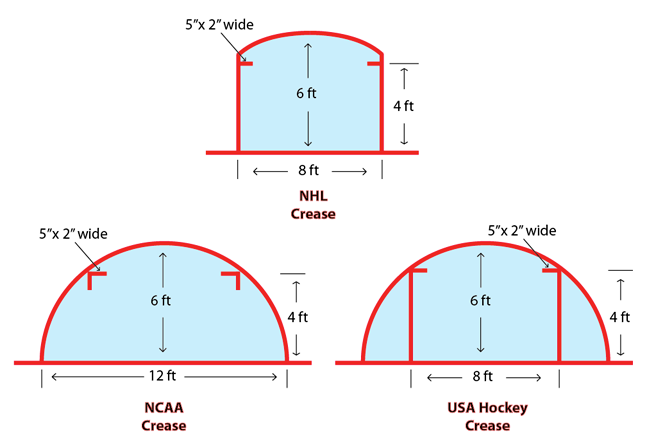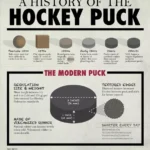The crease in hockey is a semi-circular area in front of the goal. It is where the goalie operates and restricts opposing players.
The crease is crucial in hockey, marking the territory where goalies perform their defensive duties. This blue-painted area ensures goalies have space to defend against shots without interference. Players from the opposing team can only enter this zone under certain conditions, preventing disruptions to the goalie’s focus and movements.
The crease’s dimensions and rules are strictly regulated, making it a fundamental aspect of the game. Understanding the crease helps fans and players appreciate the strategic elements involved in scoring and defending goals. It plays a significant role in the fast-paced and competitive nature of hockey.
Credit: www.quora.com
Introduction To The Crease
The crease in hockey is a vital area on the ice. It impacts gameplay and strategy significantly. Understanding the crease is essential for players and fans alike.
Definition
The crease is a semi-circular area in front of the goal. It is painted blue and extends six feet from the goal line. The lines are part of the crease.
Any action within the crease affects the game. Goalies have special privileges in this area. Opposing players face restrictions when entering.
Importance In The Game
The crease is crucial for protecting the goalie. It ensures the goalie has space to work. This space helps prevent interference from opposing players.
Rules around the crease are strict. Violations can result in penalties. These rules ensure fair play and safety.
| Aspect | Details |
|---|---|
| Location | In front of the goal |
| Size | Six feet from the goal line |
| Color | Blue |
Understanding the crease helps in appreciating the game. Fans and players benefit from knowing its rules and purpose. The crease is more than just a marked area; it is a key part of hockey.
Crease Dimensions
The crease is a crucial part of a hockey rink. Understanding its dimensions helps players and fans alike. The crease ensures fair play and protects the goalies. Let’s dive into the crease dimensions in hockey.
Standard Measurements
The standard dimensions of the crease are specific. The crease is a half-circle in front of the goal. Its radius is six feet from the goal line. The width of the crease is eight feet.
The goalie’s area within the crease measures four feet. This ensures goalies have room to move and protect the net. The dimensions are the same for most leagues.
Variations By League
Different leagues may have slight variations. In the NHL, the crease has a specific shape. It includes a half-circle with additional straight lines. These lines extend from the goal line to the front of the crease.
In international play, the crease dimensions may vary. The International Ice Hockey Federation (IIHF) uses a different shape. Their crease is more rectangular with rounded edges. The IIHF crease is also six feet deep but narrower than the NHL’s.
| League | Shape | Dimensions |
|---|---|---|
| NHL | Half-circle with lines | 6 feet radius, 8 feet wide |
| IIHF | Rectangular with rounded edges | 6 feet deep, narrower |
Role Of The Goalie
The goalie plays a crucial role in hockey. Positioned in the crease, the goalie’s primary job is to prevent the puck from entering the net. This requires quick reflexes, strategic positioning, and an understanding of the game’s dynamics.
Rights And Responsibilities
The goalie has specific rights and responsibilities within the crease. Here are some key points:
- Only the goalie can play the puck in the crease.
- The goalie is protected from interference by opponents.
- Responsibility to stop shots and direct rebounds.
- Must clear the puck from the crease area.
- Communicate with defenders to block shots.
Restricted Area Rules
The crease is a restricted area with specific rules:
- Opponents cannot enter the crease without the puck.
- Players cannot interfere with the goalie’s movements.
- Goals are disallowed if scored with goalie interference.
- Goalies can freeze the puck to stop play.
- Defenders can clear opposing players from the crease.
The crease ensures the goalie has a fair chance to perform. Knowing the rules helps understand the game better.
Player Interference
In hockey, the crease is a special area. It protects the goalie. Players must follow rules here. Breaking these rules leads to penalties.
Penalties For Violations
Players must not interfere with the goalie in the crease. Doing so results in penalties. Here are common penalties:
- Minor Penalty: 2 minutes in the penalty box
- Major Penalty: 5 minutes in the penalty box
- Game Misconduct: Ejection from the game
Impact On Gameplay
Player interference affects the game. It can lead to goals being disallowed. It can also shift the game’s momentum.
Teams must avoid penalties. Penalties give the opposing team a power play. This gives them a chance to score.
Crease Violations
In hockey, the crease is a special area in front of the goal. Players must follow strict rules within the crease. Violating these rules can lead to penalties. This section will explore common violations and their consequences.
Common Violations
Several actions can lead to crease violations. Here are some common ones:
- Goalie Interference
- Standing in the Crease
- Contact with Goalie
Consequences And Penalties
Crease violations come with consequences. Here is what can happen:
| Violation | Penalty |
|---|---|
| Goalie Interference | Minor Penalty |
| Standing in the Crease | Goal Disallowed |
| Contact with Goalie | Minor Penalty |
Players must respect the crease to avoid these penalties. This ensures fair play and safety for goalies.
Historical Changes
The crease in hockey has undergone significant changes over the years. These changes have shaped the way the game is played today. Understanding the historical changes provides insight into the evolution of the game.
Evolution Of Rules
The rules surrounding the crease have evolved significantly. Initially, the crease was a simple semi-circle. Over time, its shape and size have changed to improve gameplay.
In the early 20th century, the crease was expanded. This was done to give goalies more room to maneuver. Later, the NHL introduced a rectangular crease, which is still used today.
Notable Rule Changes
Several key rule changes have impacted the crease. These changes were implemented to enhance fairness and safety.
- 1945: The NHL introduced a rule prohibiting players from entering the crease before the puck.
- 1991: The NHL mandated a new crease design, changing its dimensions.
- 1999: The “skate in the crease” rule was eliminated. This allowed goals scored with a player’s skate in the crease.
These rule changes have made the game faster and more exciting. They have also increased the role of the goalie in defending the net.
Tactics And Strategies
The crease in hockey is a crucial area on the ice. It plays a significant role in both defensive and offensive strategies. Understanding these tactics can make a big difference in a game.
Defensive Strategies
Defending the crease is vital to prevent goals. Here are some key strategies:
- Positioning: Defenders must stay between the puck and the goalie.
- Blocking Shots: Use the body or stick to block shots.
- Clearing the Crease: Push opposing players out of the crease area.
- Communication: Goalies and defenders must talk to avoid confusion.
| Strategy | Purpose |
|---|---|
| Positioning | Keep attackers away from the goalie |
| Blocking Shots | Reduce scoring chances |
| Clearing the Crease | Maintain visibility for the goalie |
| Communication | Ensure coordinated defense |
Offensive Approaches
Attacking the crease is essential for scoring goals. Here are some effective approaches:
- Screening the Goalie: Stand in front of the goalie to block their view.
- Rebounds: Be ready to shoot the puck after a save.
- Quick Passes: Move the puck quickly to create scoring chances.
- Crash the Net: Rush the crease area to overwhelm the defense.
Utilizing these tactics can create more scoring opportunities. They are key to a successful offense.
Famous Crease Controversies
The crease in hockey is a critical area. It’s where many controversies happen. These famous crease controversies have shaped the game. They have also taught important lessons to players and fans.
Memorable Incidents
One of the most famous incidents happened in the 1999 Stanley Cup Finals. The Dallas Stars faced the Buffalo Sabres. Brett Hull scored the winning goal. His skate was in the crease, causing an uproar. Many fans and experts debated this goal for years.
Another memorable incident occurred in the 2004 playoffs. The Calgary Flames played against the Tampa Bay Lightning. Martin Gelinas appeared to score a goal. The puck seemed to cross the line. Officials ruled it no goal. This decision changed the series outcome.
In the 2017 playoffs, the Nashville Predators faced the Pittsburgh Penguins. A controversial call occurred. Officials disallowed a Predators’ goal. They said the play was offside. Fans and analysts debated this call endlessly.
Lessons Learned
These controversies highlight the importance of clear rules. The NHL has made changes to avoid confusion. Video review is now used to check close plays. This ensures fair decisions.
Players have also learned to be more cautious. They avoid the crease to prevent penalties. Coaches emphasize the importance of staying outside the crease. This helps avoid costly mistakes.
Fans have learned to accept controversial calls. They understand that officials make mistakes. The focus is now on improving the game. Technology and rule changes help make the game fairer.
| Incident | Teams | Outcome |
|---|---|---|
| 1999 Stanley Cup Finals | Dallas Stars vs. Buffalo Sabres | Controversial goal by Brett Hull |
| 2004 Playoffs | Calgary Flames vs. Tampa Bay Lightning | Disallowed goal by Martin Gelinas |
| 2017 Playoffs | Nashville Predators vs. Pittsburgh Penguins | Disallowed goal due to offside |
Tips For Beginners
Understanding the crease in hockey is crucial for beginners. The crease is the area in front of the goal. Learning how to navigate it can improve your game. Let’s dive into some tips for beginners.
Learning The Rules
First, know the rules of the crease. The crease is a painted, semi-circular area in front of the goal. Only the goalie and the puck can be inside the crease.
- Players can’t enter the crease unless the puck is there.
- If a player scores while in the crease, the goal won’t count.
Study these rules to avoid penalties. Practice staying outside the crease during gameplay. This will help you avoid fouls and improve your positioning.
Improving Skills
Enhancing your skills around the crease is essential. Work on your footwork and agility. This will help you move quickly in and out of the crease.
- Practice skating drills to improve speed.
- Work on stopping and starting quickly.
- Develop strong puck-handling skills.
Focus on shooting from outside the crease. This will help you score goals legally. Train with a partner to simulate real game situations.
Here’s a quick table to summarize key points:
| Tip | Description |
|---|---|
| Know the Rules | Understand the crease rules to avoid penalties. |
| Footwork | Improve agility and speed around the crease. |
| Puck Handling | Develop strong skills to control the puck. |
| Shooting | Focus on shooting from outside the crease. |
Mastering these tips will make you a better player. Remember to practice regularly and stay focused. Good luck on the ice!

Credit: travelhockeyclub.com
:max_bytes(150000):strip_icc()/Hockey_goal_84872184-56a77fb65f9b58b7d0eb0e19.jpg)
Credit: www.liveabout.com
Frequently Asked Questions
What Is The Point Of The Crease In Hockey?
The crease in hockey protects the goalie from interference. It ensures fair play by restricting opposing players’ access.
Can You Be In The Crease And Score A Goal?
Yes, players can be in the crease and score a goal, but they must not interfere with the goalie.
Can You Shoot In The Crease In Hockey?
Yes, players can shoot in the crease in hockey. However, they must not interfere with the goalie.
Why Do Goalies Carve Up The Crease?
Goalies carve up the crease to improve traction and reduce sliding. This helps them maintain better control and stability.
Conclusion
Understanding the crease in hockey is crucial for players and fans alike. It defines key gameplay rules and strategies. Respecting the crease can prevent penalties and enhance the game experience. Stay informed and enjoy the sport even more. Dive deeper into hockey to appreciate its intricate rules and thrilling action.


